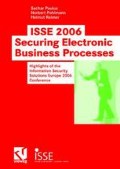Abstract
Security tokens and RFID-tags are playing an increasingly important role in the authentication of persons and devices, e.g. controlling access to services and protecting the value of goods and digital content. In order to provide the required security level they are used in combination with a cryptographic algorithm. State of the art algorithms are so sophisticated nowadays that they are virtually immune against mathematical attacks. Hence, the offered security level essentially depends on the secrecy of the employed keys. Several studies have shown that the secrecy of keys stored in memory is not guaranteed when physical attacks are used.
Recently, Physical Unclonable Functions (PUFs) were introduced as an identification tool to build secure tokens. In this paper, we extend this setting and show how PUFs can be used for generating and storing keys in a way that is secure even against physical attacks. This enables new strong security devices such as unclonable tokens, secure key storage devices and unclonable REID-tags. These are briefly described together with some applications.
Access this chapter
Tax calculation will be finalised at checkout
Purchases are for personal use only
Preview
Unable to display preview. Download preview PDF.
References
Unicate BV’s ‘3DAS’ system, http://www.andreae.com/Unicate/Appendix/%20l.htm, 1999.
Bauder D. W: An Anti-Counteifeiting Concept for Currency. Systems Research Report PTK-1 1990, Sandia National Laboratories, 1983.
Buchanan J. D. R., Cowburn R. P., Jausovec A., Petit D., Seem P., Xiong G., Atkinson D., Fenton K., Allwood D. A., Bryan M. T.: Forgery: ‘Fingerprinting’ documents and packaging. Nature 436 (28 Jul 2005), Brief Communications, p.475.
Dodis Y., Reyzin M., Smith A.: Fuzzy Extractors: How to generate strong keys from biometrics and other noisy data. In: Cachin and Camenisch, (Eds.): Proceedings of Eurocrypt 2004, Lecture Notes in Computer Science, volume 3027, Springer-Verlag, 2004, p. 523–540.
Gassend B.: Physical Random Functions, Master’s Thesis, MIT 2003.
Gassend B., Clarke D., van Dijk M., Devadas S.: Controlled Physical Random Functions. Proc. 18th Annual Computer Security Applications Conf., Dec. 2002.
Gassend B., Clarke D., van Dijk M., Devadas S.: Silicon Physical Random Functions, Proc. 9th ACM Conf. on Computer and Communications Security, Nov. 2002.
Kirovski D.,: A Point-Subset Compression Algorithm for Fiber-based Certificates of Authenticity, IEEE Proc. ISIT 2004, p.173.
Linnartz J. P., Tuyls. P.: New Shielding Functions to Enhance Privacy and Prevent Misuse of Biometric Templates, Proc. 4th International Conference on Audio and Video based Biometric Person Authentication (2003), LNCS 2688, Springer-Verlag, p. 238–250.
Magnor M., Dorn P., Rudolph W.: Simulation of confocal microscopy through scattering media with and without time gating, J. Opt. Soc. Am. B, Vol. 19,no. 11 (2001), p. 1695–1700.
Pappu R.: Physical One-Way Functions.. Ph.D. thesis, MIT 2001.
Posch R.: Protecting Devices by Active Coating, Journal of Universal Computer Science, vol.4, no.7 (1998), p.652–668.
Pappu R., Recht B., Taylor J., Gershenfeld N.: Physical One-Way Functions, Science Vol. 297, Sept 2002, p.2026.
Škorić B., Tuyls P., Ophey W.: Robust key extraction from Physical Uncloneable Functions. In: Ioannidis, Keromytis, Yung (Eds.): Proc. ACNS 2005, LNCS 3531, p.407–422.
Tuyls P., Batina L.: RFID-TagsforAnti-Counterfeiting, In D. Pointcheval (ed.): ‘Topics in Cryptology’-CT-RSA 2006, The Cryptographers’ Track at the RSA Conference, LNCS 3860, Springer-Verlag, p. 115–131.
Tuyls P., Škorić B.: Secret Key Generation from Classical Physics. In: S. Mukherjee et al (Eds.): ‘Amlware: Hardware Technology Drivers of Ambient Intelligence’, Philips Research Book Series Vol. 5, Kluwer, 2005., p. 421–447.
Tuyls P., Škorić B., Schrijen G. J., Wolters R., van Geloven J., Verhaegh N., Kretschman H.: Read-p roof hardware from protective coatings, accepted at CHES 2006.
Author information
Authors and Affiliations
Rights and permissions
Copyright information
© 2006 Friedr. Vieweg & Sohn Verlag | GWV-Fachverlage GmbH, Wiesbaden
About this chapter
Cite this chapter
Tuyls, P., Škorić, B. (2006). Physical Unclonable Functions for enhanced security of tokens and tags. In: ISSE 2006 — Securing Electronic Busines Processes. Vieweg. https://doi.org/10.1007/978-3-8348-9195-2_4
Download citation
DOI: https://doi.org/10.1007/978-3-8348-9195-2_4
Publisher Name: Vieweg
Print ISBN: 978-3-8348-0213-2
Online ISBN: 978-3-8348-9195-2
eBook Packages: Computer ScienceComputer Science (R0)

